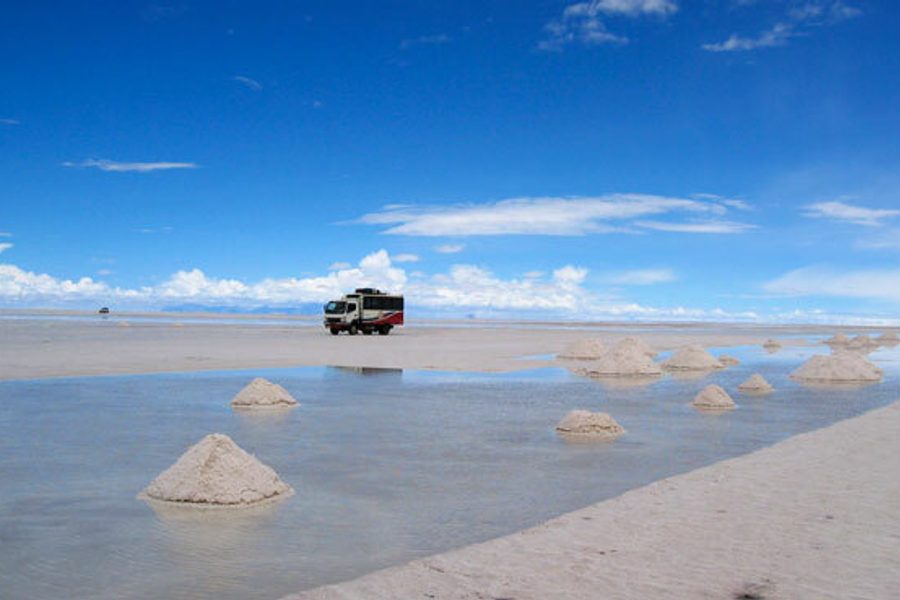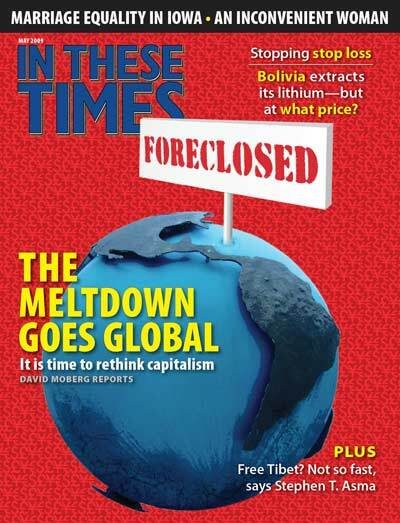
UYUNI, Bolivia – Under the honeycombed crust of the salt flats of Uyuni, Bolivia, lies roughly half of the world’s lithium. Lithium-Ion (LiIon) batteries are the reason that the world’s more than 2 billion cell phones are light and pocket-sized. In recent years, this scarce element has won fame for its potential use in battery-powered cars, and in the economic stimulus package, President Obama directed tens of billions of dollars to fund lithium battery manufacturing.
In impoverished but mineral-rich Bolivia, President Evo Morales laid the cornerstone of a lithium refinery pilot plant in May 2008, with the hopes that its profits will fund social programs in the country. But numerous obstacles to a full-fledged industry exist, and it is unclear if Bolivia will be able to participate in the market sooner than 2020.
Meanwhile, concerns remain about the environmental impact of extraction and refining, and whether the LiIon battery is really the “deus ex machina” that the auto industry is looking for.
Lithium’s economic role
Lithium, the lightest known metal, has a range of uses – from acting as a mood-stabilizing drug to powering batteries. At an elemental level, lithium’s small atomic radius grants it the highest electro-negativity of all alkali metals, resulting in greater malleability, a lower boiling point than most metals, and a superlative capacity for use in batteries.
LiIon batteries are considered revolutionary because they are lighter, smaller, tougher and can hold a charge for eight times longer than alkaline versions. Many modern electronics are now powering up with South American or Tibetan lithium. And though nickel batteries are currently cheaper than their lithium counterparts, the gap is expected to close with an increased lithium supply. Since 2004, world production has skyrocketed, from 16 tons to 25 tons per year.
In arid, southwestern Bolivia, distant islands and volcanoes seem to float over the blindingly white plain of the Salar de Uyuni, a salt flat 3,670 meters above sea level.
The Salar is the remains of a vast inland sea. According to local legend, it is the dried traces of the breast milk and tears of a disconsolate goddess searching for her lost child. With an area of 110 miles by 50 miles, it is the largest salt flat in the world. The light refracted by the crystallized salt made it recognizable to Neil Armstrong as he stood on the moon.
The salt flat has long been a resource for local indigenous peoples. In towns on the banks of the Salar, most houses and buildings are made of bricks of the crystallized mineral. Residents work in salt, drying and loading it in trucks to be taken to refineries in the lowlands, and carving it into trinkets to sell to the 60,000 tourists who visit each year.
The city of Uyuni is a quiet town of a dozen square blocks. In city hall, development consultant Luis Ramirez R’os says that lithium could help the regional economy.
“We want it to go toward improving the quality of life in this area abandoned by the state and national government,” he says. “Hopefully they will set up this industry very carefully, and it will go toward the benefit of the people.”
On the edge of town, in the FRUTCAS (Southern High Plains Regional Federation of Workers and Peasants) office, men of all ages wait in the courtyard for work. In a long office decorated with political posters, FRUTCAS Executive Secretary Francisco Quisbert shrugs, “The positions are already filled,” he says, “but people keep coming.”
Quisbert believes that any benefit derived from lithium should belong to the people.
“Our grandparents lived off the Salar, from the salt,” he says. “Every year they carried the salt in llama caravans to the valleys, and there they traded for the goods of the valleys … and that’s what they lived on. But the truckers took this away from us, now the truckers take the salt. And that’s why we say, if we used to live off the Salar, now we have to keep living off the Salar.”
Getting multinationals out
In the 1990s, proposals to sell the lithium reserves to the American Lithium Corporation were dropped after massive protests decried the benefits given to the company. Morales’ 2005 election as president was widely perceived as a mandate for nationalizing the extraction of natural resources. One of Morales’ first acts as president was a partial nationalization of the country’s gas reserves. With a similar goal in mind, Quisbert says, “We told President Morales that ‘the lithium needs to be worked.’ “
To many Bolivians, the potential of lithium wealth represents a symbolic remuneration for 500 years of natural resource looting by foreign corporations. Bolivian political analyst and former vice-minister of mining, Pedro Mariobo Moreno, calls for the “state monopoly of all the riches of the Salar of Uyuni … to avoid the third massive sacking of our natural resources, after silver and tin.”
To Marcelo Castro, who is directing the construction of a pilot lithium refinery, the creation of the plant “in the Salar, one of the farthest away places, should make history as the beginning of the recuperation of our self respect.”
The government has stated that the plant and its 14,000 square meters of evaporation pools will open in January 2010, but Castro says many hurdles must be overcome to begin studying the process of extraction, let alone exporting the material.
“When we first got here, the place where we were going to start building wasn’t a blank slate, it was less than a blank slate,” he says. “We have big problems – but they are the same as most Bolivians encounter: no clean water, no electricity, no Internet or telephone, not even a telegraph. The roads are a disaster. In a country like ours, constructing a lithium plant is a great challenge.”
But Castro’s goal is to eventually construct an industrial plant with the ability to produce 20,000 metric tons of lithium carbonate per year.
“Our great grandchildren are going to be the ones that will really begin to enjoy the full benefits, because arguably, the quantity of lithium that we have has to make us into one of the biggest producers,” he says.
Such a long-term perspective is necessary because the lithium carbonate that the plants produce will still need to be refined into metallic lithium and manufactured into batteries in order to turn a substantial profit.
Environmental concerns
On a February trip to France, Morales said that lithium mined in Bolivia should not be sold cheaply to factories in other countries, and that batteries and cars made with the mineral should be produced in Bolivia itself. During the trip, Morales met with the French company Bollore to discuss plans for the creation of partially nationalized plants to produce LiIon batteries and LiIon-powered cars in Bolivia.
However, several factors put the Salar de Uyuni at a disadvantage to the current largest lithium producer, Chile’s Salar de Atacama. Bolivia’s lithium-rich brine is lower in quality than the Atacama, according to a May 2008 report by the Meridian International Research Consultancy, an independent research firm focused on renewable energy technology. “The total amount of lithium stored in the epi-centre is … comparable to the Atacama, but spread out over at least twice the surface area,” the report found. That means, the report said, “a much greater area of the Salar will have to be exploited for an equivalent lithium production.”
The thin layer of the deposit could make pumping from wells not feasible, and could lead to huge trenches or the destruction of large areas of the Salar.
Then there is the question of the purity of the Salar de Uyuni’s lithium. As Bolivian chemist Pedro Crespo Avizuri, who has studied the Salar and its minerals since the ’80s, notes, “Nature is crazier than fiction. And nature put a ton of magnesium in the Salar.” Uyuni’s magnesium to lithium ratio is three times as high as the Atacama, making it more difficult to refine the salt into lithium carbonate.
Finally, the evaporation rate in Uyuni is only 40 percent of that of the Atacama, which means refining will take more time. “In fact,” as the Meridian report concludes, “most of the lithium in the Salar de Uyuni will remain inaccessible or would take decades to extract.”
The high concentrations of magnesium and the lower evaporation rate mean the Bolivian government’s intention to produce one and a half times the Atacama’s current production is unlikely. Realistically, it will most likely take any Bolivian refinery until 2015 to reach even a sixth of that rate of production, and until 2020 (at least) to reach the government’s goal.
Learning from the past
For the last 500 years, mining has caused irreversible environmental damage to Bolivian land and communities. Mines continue to use chemicals – including cyanide – to refine ore, discharging hundreds of thousands of tons of toxic sludge into rivers every year.
In Uyuni, Quisbert tries to assuage concerns about the environmental ramifications of lithium exploitation. He says past fights in Bolivia against water exportation and the voracious water consumption of the San Cristobal mine, now Sumitomo, have been detrimental to local farmers. Given this experience, Quisbert is surprisingly cavalier about possible environmental ramifications.
“We understand that it wouldn’t bring much pollution,” he says, “because it’s a process of evaporation, but there’s always something left over.”
In general, official response to such environmental concerns is characterized by indifference. This is alarming to Elizabeth Lopez Canelas of the Bolivian Environmental Defense League (FOBOMADE).
“There’s no information, no water use studies,” Lopez Canelas says. “So how can they begin to project what the long-term effects might be? This is supposedly a project to improve the region, but what if it makes living impossible? How is that sustainable development?”
She says it has been difficult to address environmental concerns with the government and social organizations. Past struggles have created a public perception that it is the people’s right to benefit from natural resource extraction. In addition, Lopez says, it is difficult to criticize the populist rhetoric of the current administration without appearing to support the political opposition.
Official discourse calls the refinery a “closed circuit” system, which means, according to Castro, “We’ll throw materials that we don’t use back into the brine with a few less elements.”
A Report by the Bolivia Center Of Documentation And Information (CEDIB) states that salts precipitated in the evaporation pools “will be returned via brineduct to the Río Grande de Lípez” (emphasis added). However, according to Lopez Canelas, peasants currently use the slightly saline water of the river for irrigation, which could be jeopardized by adding more salt.
Other concerns include the effects of the refining structures and process on people, animals and the Salar itself. According to chemist Pedro Crespo Avizuri, “A key question is what to do with the mountains of magnesium we’ll make in the process.”
Though there are no plans for permanent constructions in the Salar, covering its surface with brine extraction facilities and evaporation ponds could irreversibly damage the surface of the salt flat and the Rio Grande delta, used by wild flamingos as an annual breeding ground.
What’s more, exposure to lithium for extended periods is potentially dangerous because of the highly corrosive base, lithium hydroxide (LiOH), formed when lithium reacts with water. Existing processing plants produce sulfur dioxide, which has been known to cause breathing difficulties, pulmonary edema and even death.
The Meridian report argues that extracting “enough lithium to meet even 10 percent of global automotive demand would cause irreversible and widespread [environmental] damage, and that LiIon propulsion is incompatible with the notion of the ‘Green Car.’ ”
The current lithium battery buzz also doesn’t address the fact that LiIon batteries can only store energy, and the question of where the great quantity of energy to power these electric cars and machines will come from remains.
Given these technical and environmental problems, hopeful Bolivians and electric car enthusiasts might want to reconsider whether a “lithium era” is really the best solution to poverty and the problems of petroleum.





